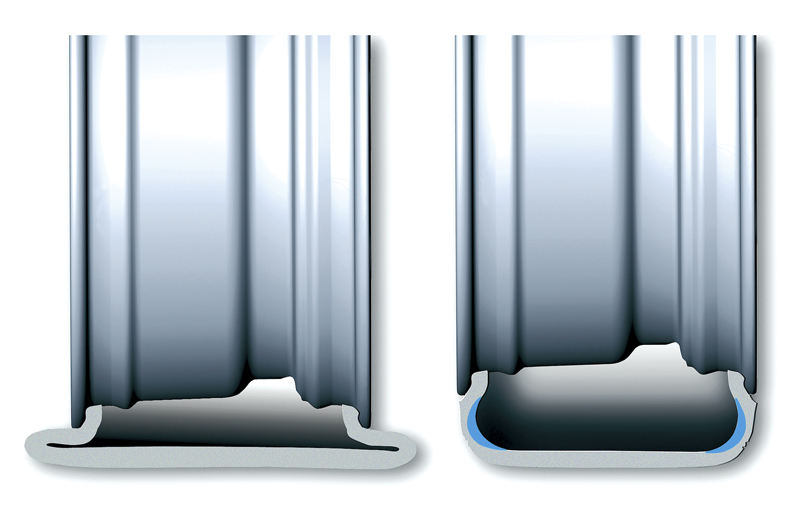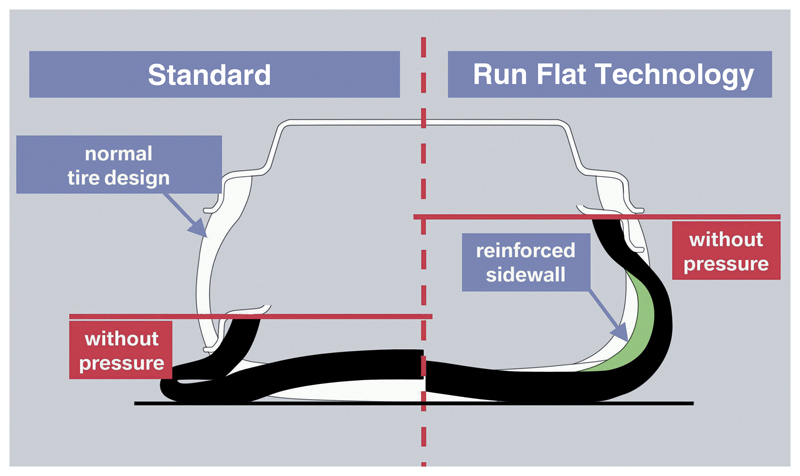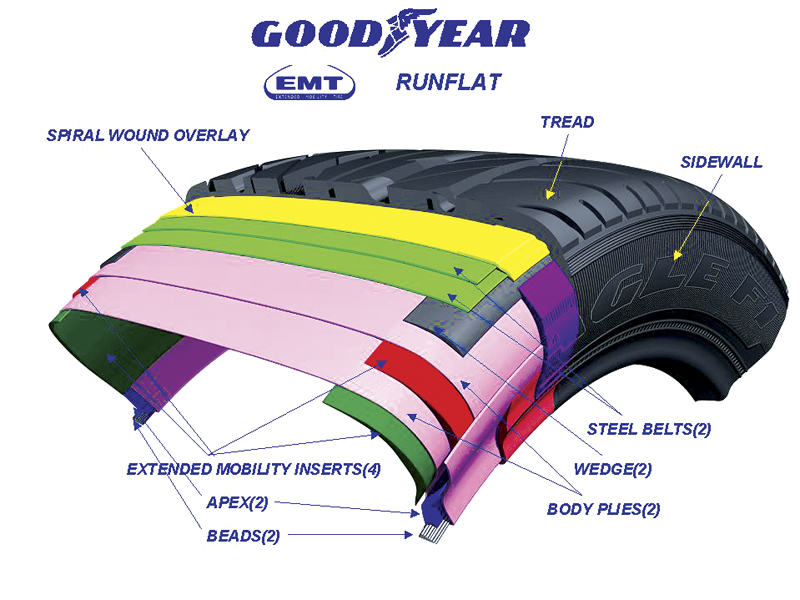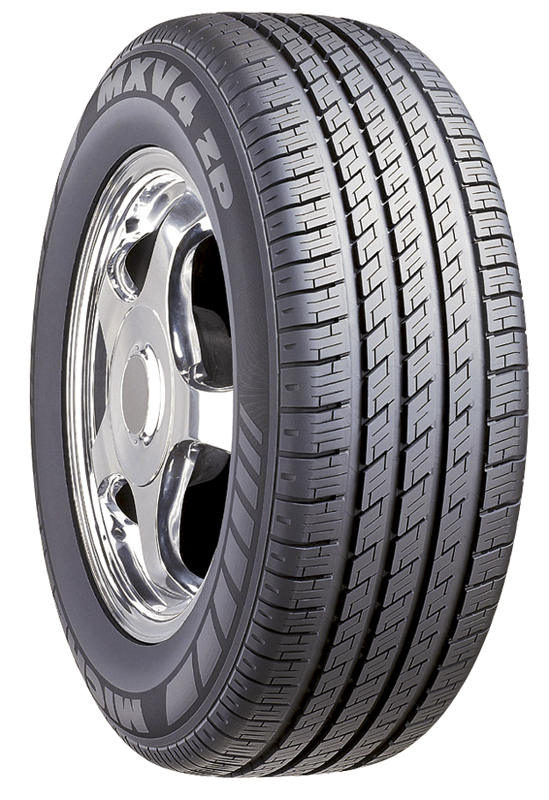

If you had X-ray vision, you could see that the sidewall on a 3 Series run-flat is different from that of a conventional tire.
Few things are more frightening to a driver than a blowout because several bad things start happening all at once. A trained, experienced driver may be able to bring his or her vehicle to a safe stop after a blowout. However, many drivers just hang on and hope for the best, or, worse, slam on the brakes. Even for an experienced driver, a blowout while driving on a highway with other vehicles nearby is scary.
“Run-flat†tires, which still support the car and provide control even when air pressure is lost, greatly reduce the danger of a blowout. Although run-flats have been available for many years, interest in these tires has surged recently.
BMW has offered run-flat tires as standard or optional equipment on selected models since the late 1990s. Equipped with run-flats, a BMW can be driven some distance even though the tire has no air in it. However, the maximum recommended speed for a run-flat without air is 50 mph. So, your customer can drive to your shop for tire replacement, just not at high speed.

With its stronger, reinforced sidewall, a run-flat tire can support a BMW even when all air pressure has been lost.
In addition to their other benefits, run-flats eliminate the hassle and potential risk of pulling onto the shoulder of a busy highway to replace a flat tire. These tires even offer a convenience benefit, freeing up trunk space because a spare tire and jack are not necessary with run-flats.
Three Types
Tire makers use one of three technologies or designs to address flat tire concerns.
- Self-Sealing. Self-sealing tires have a thin, flexible liner bonded to the underside of the tire carcass that automatically seals punctures. However, the liner may fail, especially if a rock or nail causes a large hole in the tread.
- Support Ring. Michelin’s PAX tire and wheel combination has a rubber ring bonded to the wheel that supports the weight of the vehicle after losing air pressure. These tires and wheels are of a unique size. You cannot mount PAX tires on any other wheel and PAX wheels will not accept any other tire.
- Self Supporting. The most common run-flats have a sidewall strong enough to support the tire and car, for a limited time, after the loss of air pressure. The composition of the sidewall provides the additional strength. These tires also have a special bead that securely bonds the tire to the wheel to help prevent the bead from breaking loose. OE run-flats on BMWs are self supporting.
Drivers complained that the early generation run-flats were too hard, resulting in a harsher ride and reduce performance compared to a conventional tire. These complaints have just about disappeared with current run-flats. The tires have a less harsh ride and BMW has tweaked its suspension, steering, and braking to adapt to the unique characteristics of run-flats. A BMW equipped with factory specified
run-flat tires has the superior performance and handling that BMWs are noted for.
Run-flat tires, especially self supporting tires, must only be used on a BMW equipped with an onboard tire monitor system. If a run-flat is damaged, it can still be driven up to a specified number of miles (this depends on the model and load conditions,but can be as much as 150 miles in certain cases), as long as vehicle speed is below 50 mph. The driver probably won’t notice a problem. Even if the car is stopped, the tire may not look flat. However, if driven more than the maximum distance, or at speeds greater than about 50 mph, the tire may fail. Without an onboard tire monitoring system, drivers may not have any warning of impending tire failure.
Tradeoffs

On the inside, a run flat is assembled in a different way, using different materials, than a standard tire (courtesy Goodyear).
Although the convenience benefits are significant, there are some tradeoffs that should be considered when evaluating run-flat tires.
- Cost. Run-flats typically are more expensive than comparable ordinary pneumatic tires. An “every day†run-flat can cost as much as a premium performance tire. And a high-performance run-flat will be more expensive than a premium performance conventional tire.
- Tread life. There were complaints with early run-flats of rapid tread wear because the tires had a relatively soft tread compound to help offset the stiffness of the sidewalls. Tire manufacturers say the latest run-flats don’t have this problem, and in any case tread wear is rated using the same standards as are used for other tires.
- Range. The specified range without air pressure isn’t a problem in any urban area. The run-flat will get the driver to a repair shop safely. But as anyone who has driven a BMW across country knows, there are long stretches of open road where you can go several hundred miles and only see small towns, which may not have a shop that stocks run-flat tires. Of course, being able to go a considerable distance on a run-flat is still better than being stopped by a flat tire out in the middle of nowhere!

From the outside, you can’t see any difference between a run-flat tire and a conventional pneumatic tire(courtesy Michelin).
Run-flats still have the benefit of allowing the driver to control the vehicle when a blowout occurs. One cause of blowouts is driving on an underinflated tire, which causes excessive flexing and overheating. With the advent of onboard tire monitoring systems, drivers are warned when any tire is low on air pressure, so this cause of failure will probably become less frequent in the future. Other types of tire damage that can cause a blowout, however, such as road hazards, will continue to be a problem, thus making run-flats a very worthwhile addition to any vehicle.
Run-flat Service
Can you fix a run-flat tire? Continental and Pirelli say “no,†which goes along with BMW’s recommendation that damaged run-flats should be replaced, never repaired. Some tire manufacturers, such as Bridgestone, Dunlop, Goodyear, and Michelin, on the other hand, allow repairs within certain limits and guidelines based on the size of the damage and how far the tire has been driven without air pressure. Even then, there are sometimes limits on how fast the vehicle may be driven after a repair is made.
You should always follow BMW’s recommendations in your shop, so your only option is to replace the tire with the same size and model run-flat. Never replace a run-flat with a conventional tire, and never mix run-flats from different manufacturers.
Fortunately, no special equipment or techniques are needed to demount, mount and balance run-flats.


0 Comments